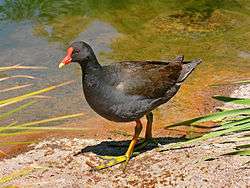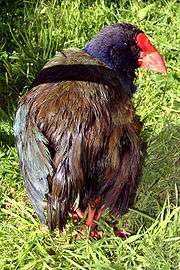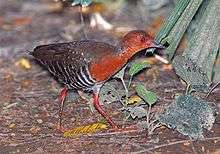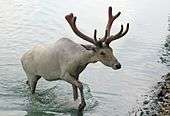Rail (bird)
| Rails Temporal range: Early Eocene–Recent | |
|---|---|
 | |
| Dusky moorhen, Gallinula tenebrosa | |
| Scientific classification | |
| Kingdom: | Animalia |
| Phylum: | Chordata |
| Class: | Aves |
| Order: | Gruiformes |
| Family: | Rallidae Rafinesque, 1815 |
| Genera | |
|
Some 40 living, and see below. | |
The rails, or Rallidae, are a large cosmopolitan family of small- to medium-sized ground-living birds. The family exhibits considerable diversity and also includes the crakes, coots, and gallinules. Many species are associated with wetlands, although the family is found in every terrestrial habitat except dry deserts, polar regions, and alpine areas above the snow line. Members of the Rallidae occur on every continent except Antarctica. There are numerous island species. The most common rail habitats are marshland or dense forest. They are especially fond of dense vegetation.[1]
Morphology

The rails are a fairly homogeneous family of small to medium-sized, ground-living birds. They vary in length from 12 to 63 cm (4.7 to 24.8 in) and in weight from 20 to 3,000 g (0.71 to 105.82 oz). Some species have long necks and in many cases are laterally compressed.
The bill is the most variable feature within the family. In some species it is longer than the head (like the clapper rail of the Americas), in others it may be short and wide (as in the coots), or massive (as in the purple gallinules).[2] A few coots and gallinules have a frontal shield, which is a fleshy, rearward extension of the upper bill. The most complex frontal shield is found in the horned coot.[3]
Rails exhibit very little sexual dimorphism in either plumage or size.
Flight and flightlessness
The wings of all rails are short and rounded. The flight of those Rallidae able to fly, while not powerful, can be sustained for long periods of time, and many species migrate annually. The weakness of their flight, however, means they are easily blown off course and thus are common vagrants, a characteristic that has led them to colonize many isolated oceanic islands. Furthermore, these birds often prefer to run rather than fly, especially in dense habitat. Some are also flightless at some time during their moult period.[4]
Flightlessness in rails is one of the best examples of parallel evolution in the animal kingdom. Of the approximately 150 historically known rail species, 31 extant or recently extinct species evolved flightlessness from volant ancestors.[5] This process created the endemic populations of flightless rails that we see on Pacific islands today.
Many island rails are flightless because small island habitats without mammalian predators eliminate the need to fly or move long distances. Flight makes intense demands, with the keel and flight muscles taking up to a quarter of a bird's weight in flying Rallidae species. Reducing the flight muscles, with a corresponding lowering of metabolic demands, reduces the flightless rail's energy expenditures.[6] For this reason, flightlessness makes it easier to survive and colonize an island where resources may be limited.[7] This also allows for the evolution of multiple sizes of flightless rails on the same island as the birds diversify to find niches.[8]
In addition to energy conservation, certain morphological traits also affect rail evolution. Rails have relatively shortened wings to begin with, which, in combination with their terrestrial habits and behavioral flightlessness, lends speed to the evolution of flightlessness, making it remarkably fast;[9] it took as little as 125,000 years for the Laysan rail to lose the power of flight and evolve the reduced, stubby wings only useful to keep balance when running quickly.[10] Indeed, some argue that it might be possible to measure the evolution of flightlessness in rails in generations rather than millennia.[7]
Another factor that contributes to the occurrence of the flightless state is a climate that does not necessitate seasonal long-distance migration; this is evidenced by the tendency to evolve flightlessness at a much greater occurrence in tropical islands than in temperate or polar islands.[11]
It is paradoxical, since rails appear loath to fly, that the evolution of flightless rails would necessitate high dispersal to isolated islands.[12] Nonetheless, three species of small-massed rails, Gallirallus philippensis, Porphyrio porphyrio, and Porzana tabuensis, exhibit a persistently high ability to disperse long-distance among tropic Pacific islands,[12] though only the latter two gave rise to flightless endemic species throughout the Pacific Basin.[13] In examining the phylogeny of G. philippensis, it becomes clear that although the species is polyphyletic, it is not the ancestor of most of its flightless descendants, revealing that the flightless condition evolved in rails before speciation was complete.[13]
A consequence of lowered energy expenditure in flightless island rails has also been associated with evolution of their "tolerance" and "approachability".[11] For example, the (non-Rallidae) Corsican blue tits exhibit lower aggression and reduced territorial defense behaviors than do their mainland European counterparts,[14] but this tolerance may be limited to close relatives.[15] The resulting kin-selecting altruistic phenomena reallocates resources to produce fewer young that are more competitive and would benefit the population as an entirety, rather than many young who would exhibit less fitness.[11] Unfortunately, with the human occupation of most islands in the past 5,000 to 35,000 years, selection has undoubtedly reversed the tolerance into a wariness of humans and predators, causing species unequipped for the change to become susceptible to extinction.[11]
Behaviour and ecology
In general, members of Rallidae are omnivorous generalists. Many species eat invertebrates, as well as fruit or seedlings. A few species are primarily herbivorous.[1] The calls of Rallidae species vary and are often quite loud. Some are whistle-like or squeak-like, while others seem un-birdlike.[16] Loud calls are useful in dense vegetation, or at night where it is difficult to see another member of the species. Some calls are territorial.[2]
The most typical family members occupy dense vegetation in damp environments near lakes, swamps, or rivers. Reed beds are a particularly favoured habitat. They are omnivorous, and those that migrate do so at night.
Most nest in dense vegetation. In general, they are shy, secretive, and difficult to observe. Most species walk and run vigorously on strong legs, and have long toes that are well adapted to soft, uneven surfaces. They tend to have short, rounded wings and although they are generally weak fliers, they are, nevertheless, capable of covering long distances. Island species often become flightless, and many of them are now extinct following the introduction of terrestrial predators such as cats, rats and pigs.
Many reedbed species are secretive (apart from loud calls), crepuscular, and have laterally flattened bodies. In the Old World, long-billed species tend to be called rails and short-billed species crakes. North American species are normally called rails irrespective of bill length. The smallest of these is the Swinhoe's rail, at 13 cm (5.1 in) and 25 grams. The larger species are also sometimes given other names. The black coots are more adapted to open water than their relatives, and some other large species are called gallinules and swamphens. The largest of this group is the takahē, at 65 cm (26 in) and 2.7 kg (6.0 lb).
The rails have suffered disproportionally from human changes to the environment, and it is estimated that several hundred species of island rail have become extinct because of this. Several island species of rail remain endangered, and conservation organisations and governments continue to work to prevent their extinction.
Reproduction
The breeding behaviors of many Rallidae species are poorly understood or unknown. Most are thought to be monogamous, although polygyny and polyandry have been reported.[17] Most often, they lay five to ten eggs. Clutches as small as one or as large as fifteen eggs are known.[17] Egg clutches may not always hatch at the same time. Chicks become mobile after a few days. They often depend on their parents until fledging, which happens at around one month.[3]
Rallidae and humans

Some larger, more abundant rails are hunted and their eggs collected for food.[18] The Wake Island rail was hunted to extinction by the starving Japanese garrison after the island was cut off from supply during World War II.[19] At least two species, the common moorhen and the American purple gallinule, have been considered pests.[18]
Threats and conservation
Due to their tendencies towards flightlessness, many island species have been unable to cope with introduced species. The most dramatic human-caused extinctions occurred in the Pacific Ocean as people colonised the islands of Melanesia, Polynesia and Micronesia, during which an estimated 750–1800 species of bird became extinct, half of which were rails.[20] Some species that came close to extinction, such as the Lord Howe woodhen, and the takahē, have made modest recoveries due to the efforts of conservation organisations. The Guam rail came perilously close to extinction when brown tree snakes were introduced to Guam, but some of the last remaining individuals were taken into captivity and are breeding well, though attempts at reintroduction have met with mixed results.
Systematics and evolution
The family Rallidae was introduced (as Rallia) by the French polymath Constantine Samuel Rafinesque in 1815.[21][22] The family has traditionally been grouped with two families of larger birds, the cranes and bustards, as well as several smaller families of usually "primitive" mid-sized amphibious birds, to make up the order Gruiformes. The alternative Sibley-Ahlquist taxonomy, which has been widely accepted in America, raises the family to ordinal level as the Ralliformes. Given uncertainty about gruiform monophyly, this may or may not be correct; it certainly seems more justified than most of the Sibley-Ahlquist proposals. On the other hand, such a group would probably also include the Heliornithidae (finfoots and sungrebes), an exclusively tropical group that is somewhat convergent with grebes, and usually united with the rails in the Ralli.
Extant (living) genera

.jpg)
.jpg)
- Himantornis – Nkulengu rail
- Canirallus (3 species)
- Coturnicops (3 species)
- Micropygia – ocellated crake
- Rallina (4 species)
- Rallicula – forest rails (4 species)
- Anurolimnas (3 species)
- Atlantisia – Inaccessible Island rail
- Laterallus (10 species)
- Nesoclopeus (1 living species, 1 recently extinct)
- Gallirallus – Austropacific rails (including Tricholimnas; 11–12 living species, 3–5 recently extinct)
- Rallus – typical rails (some 9 living species)
- Lewinia (3 species; sometimes in Rallus)
- Dryolimnas (1 living species, 1 recently extinct)
- Crecopsis – African crake (sometimes in Crex)
- Crex – corn crake
- Rougetius – Rouget's rail
- Aramidopsis – snoring rail
- Aramides – wood rails (8–9 living species, 1 recently extinct)
- Amaurolimnas – uniform crake
- Gymnocrex (3 species)
- Amaurornis – bush-hens (9 species)
- Porzana – typical crakes (13 living species, 4–5 recently extinct)
- Aenigmatolimnas – striped crake
- Cyanolimnas – Zapata rail
- Mustelirallus (3 species)
- Pardirallus (3 species)
- Eulabeornis – chestnut rail
- Habroptila – invisible rail
- Megacrex – New Guinea flightless rail
- Gallicrex – watercock
- Porphyrio – swamphens and purple gallinules (including Notornis and Porphyrula; 6 living species, 2–5 recently extinct)
- Gallinula – typical gallinules (including Edithornis and Pareudiastes; 7–9 living species, 1–3 recently extinct)
- Porphyriops – spot-flanked gallinule
- Tribonyx – nativehens; (2 living species)
- Fulica – coots (c. 10 living species, 1 recently extinct)
Additionally, there are many prehistoric rails of extant genera, known only from fossil or subfossil remains, such as the Ibiza rail (Rallus eivissensis). These have not been listed here; see the genus accounts and the articles on fossil and Late Quaternary prehistoric birds for these species.
Phylogeny
Rallidae based on the work by John Boyd.[23]
| ||||||||||||||||||||||||||||||||||||||||||||||||||||||||||||||||||||||||||||||||||||||||||||||||||||||||||||||||||||||||||||||||||||||||||||||||||||||||||||||||||||||||||||||||||||||||||||||||||||||||||||||||||||||||||||
Recently extinct genera
- Genus Nesotrochis – cave-rails (3 species; extinct prehistoric or later)
- Antillean cave rail, Nesotrochis debooyi (Puerto Rico and Virgin Islands, West Indies) – may have survived until historic times
- Haitian cave-rail, Nesotrochis steganinos (Haiti, West Indies) – prehistoric
- Cuban cave-rail, Nesotrochis picapicensis (Cuba, West Indies) – prehistoric
- Genus Diaphorapteryx – Hawkins's rail (extinct 19th century)
- Genus Aphanapteryx – Red rail (extinct mid-18th century)
- Genus Erythromachus – Rodrigues rail (extinct mid-18th century)
- Genus Cabalus – Chatham rail (sometimes included in Gallirallus; extinct c. 1900)
- Genus Mundia – Ascension crake – formerly included in Atlantisia; (late 17th century)
- Genus Aphanocrex – Saint Helena swamphen (formerly included in Atlantisia; extinct 16th century)
The undescribed Fernando de Noronha rail, genus and species undetermined, probably survived to historic times.
Late Quaternary prehistoric extinctions
- Genus Capellirallus – Snipe-rail
- Genus Vitirallus – Viti Levu rail. The holotype of Vitirallus watlingiis in the collection of the Museum of New Zealand Te Papa Tongarewa.[24]
- Genus Hovacrex – Hova gallinule
and see genus accounts
Fossil record
Fossil species of long-extinct prehistoric rails are richly documented from the well-researched formations of Europe[25] and North America, as well from the less comprehensively studied strata elsewhere:
- Genus Eocrex (Wasatch Early Eocene of Steamboat Springs, USA; Late Eocene – ?Oligocene of Isfara, Tadzhikistan)
- Genus Palaeorallus (Wasatch Early Eocene of Wyoming, USA)
- Genus Parvirallus (Early – Middle Eocene of England)
- Genus Aletornis (Bridger Middle Eocene of Uinta County, USA) – includes Protogrus
- Genus Fulicaletornis (Bridger Middle Eocene of Henry's Fork, USA)
- Genus Latipons (Middle Eocene of Lee-on-Solent, England)
- Genus Ibidopsis (Hordwell Late Eocene of Hordwell, UK)
- Genus Quercyrallus (Late Eocene -? Late Oligocene of France)
- Genus Belgirallus (Early Oligocene of WC Europe)
- Genus Rallicrex (Corbula Middle/Late Oligocene of Kolzsvár, Romania)
- Rallidae gen. et sp. indet. (Late Oligocene of Billy-Créchy, France)[26]
- Genus Palaeoaramides (Late Oligocene/Early Miocene – Late Miocene of France)
- Genus Rhenanorallus (Late Oligocene/Early Miocene of Mainz Basin, Germany)
- Genus Paraortygometra (Late Oligocene/?Early Miocene -? Middle Miocene of France) – includes Microrallus
- Genus Australlus (Late Oligocene – Middle Miocene of NW Queensland, Australia)
- Genus Pararallus (Late Oligocene? – Late Miocene of C Europe) – possibly belongs in Palaeoaramides
- Rallidae gen. et sp. indet. (Bathans Early/Middle Miocene of Otago, New Zealand)[27]
- Rallidae gen. et sp. indet. (Bathans Early/Middle Miocene of Otago, New Zealand)[28]
- Genus Miofulica (Anversian Black Sand Middle Miocene of Antwerp, Belgium)
- Genus Miorallus (Middle Miocene of Sansan, France -? Late Miocene of Rudabánya, Hungary)
- Genus Youngornis (Shanwang Middle Miocene of Linqu, China)
- Rallidae gen. et sp. indet. (Sajóvölgyi Middle Miocene of Mátraszõlõs, Hungary)[29]
- Rallidae gen. et sp. indet. (Middle Miocene of Grive-Saint-Alban, France)[30]
- Rallidae gen. et sp. indet. (Late Miocene of Lemoyne Quarry, USA)
- Rallidae gen. et sp. indet. UMMP V55013-55014; UMMP V55012/V45750/V45746 (Rexroad Late Pliocene of Saw Rock Canyon, USA)
- Rallidae gen. et sp. indet. UMMP V29080 (Rexroad Late Pliocene of Fox Canyon, USA)
- Genus Creccoides (Blanco Late Pliocene/Early Pleistocene of Crosby County, USA)
- Rallidae gen. et sp. indet. (Bermuda, West Atlantic)
- Rallidae gen. et sp. indet. (formerly Fulica podagrica) (Late Pleistocene of Barbados)[31]
- Genus Pleistorallus (mid-Pleistocene New Zealand).[32] The holotype of Pleistorallus flemingi is in the collection of the Museum of New Zealand Te Papa Tongarewa.[33]
Doubtfully placed here
These taxa may or may not have been rails:
- Genus Ludiortyx (Late Eocene) – includes "Tringa" hoffmanni, "Palaeortyx" blanchardi, "P." hoffmanni
- Genus Telecrex (Irdin Manha Late Eocene of Chimney Butte, China)
- Genus Amitabha (Bridger middle Eocene of Forbidden City, USA) – phasianid?
- Genus Palaeocrex (Early Oligocene of Trigonias Quarry, USA)
- Genus Rupelrallus (Early Oligocene of Germany)
- Neornithes incerta sedis (Late Oligocene of Riversleigh, Australia)[34]
- Genus Euryonotus (Pleistocene of Argentina)
The presumed scolopacid wader Limosa gypsorum (Montmartre Late Eocene of France) is sometimes considered a rail and then placed in the genus Montirallus.[35]
See also
-
 Animals portal
Animals portal -
 Birds portal
Birds portal -
 Biology portal
Biology portal - List of Gruiformes by population
Footnotes
- 1 2 Horsfall & Robinson (2003): pp. 206–207
- 1 2 Horsfall & Robinson (2003): p. 208
- 1 2 Horsfall & Robinson (2003): p. 210
- ↑ Horsfall & Robinson (2003): p. 209
- ↑ Kirchman (2012)
- ↑ McNab & Ellis (2006)
- 1 2 McNab (1994)
- ↑ Trewick (1997)
- ↑ Livezey 2003
- ↑ Slikas et al. (2002)
- 1 2 3 4 McNab 2002
- 1 2 McNab and Ellis 2006
- 1 2 Kirchman 2012
- ↑ Perret and Blondel 1993
- ↑ Granjon and Cheylan 1989
- ↑ Horsfall & Robinson (2003): p.207
- 1 2 Horsfall & Robinson (2003): pp. 209–210
- 1 2 Horsfall & Robinson (2003): p. 211
- ↑ BLI (2007)
- ↑ Steadman (2006)
- ↑ Rafinesque, Constantine Samuel (1815). Analyse de la nature ou, Tableau de l'univers et des corps organisés (in French). Palermo: Self-published. p. 70.
- ↑ Bock, Walter J. (1994). History and Nomenclature of Avian Family-Group Names. Bulletin of the American Museum of Natural History. Number 222. New York: American Museum of Natural History. pp. 136, 252.
- ↑ Boyd, John (2007). "GRUAE I- Opisthocomiformes & Gruiformes". Retrieved 30 December 2015.
- ↑ "Vitirallus watlingi; holotype". Collections Online. Museum of New Zealand Te Papa Tongarewa. Retrieved 18 July 2010.
- ↑ Mlíkovský (2002)
- ↑ A small species of rail: Hugueney et al. (2003)
- ↑ Dozens of mostly broken isolated skull and limb bones of a rail or crake the size of a slaty-breasted or small buff-banded rail: Worthy et al. (2007)
- ↑ Quadrate (MNZ S.40957) and 2 femora (MNZ S.42658, S.42785) of a rail or crake the size of a large buff-banded rail: Worthy et al. (2007)
- ↑ Several limb bones of a smallish rail: Gál et al. (1998–99)
- ↑ Partial hand of a common moorhen-sized rail: Ballmann (1969)
- ↑ Storrs L. Olson: A new species of Nesotrochis from Hispaniola, with notes on other fossil rails from the West Indies (Aves: Rallidae) In: Proceedings of the Biological Society of Washington 87, 38:p 439–450, 1974
- ↑ Worthy, T.H. (1997). "A mid-Pleistocene rail from New Zealand". Alcheringa: An Australasian Journal of Palaeontology. 21 (1): 71–78. doi:10.1080/03115519708619186.
- ↑ "Pleistorallus flemingi; holotype". Collections Online. Museum of New Zealand Te Papa Tongarewa. Retrieved 18 July 2010.
- ↑ Specimen QM F40203. A left carpometacarpus piece of a bird about the size of Lewin's rail. Probably from a rail, but it is too damaged to determine its affiliations more precisely: Boles (2005)
- ↑ Olson (1985), Mlíkovský (2002)
References
- Ballmann, Peter (1969): Les Oiseaux miocènes de la Grive-Saint-Alban (Isère) [The Miocene birds of Grive-Saint-Alban (Isère)]. Geobios 2: 157–204. [French with English abstract] doi:10.1016/S0016-6995(69)80005-7 (HTML abstract)
- BirdLife International (BLI) (2007): Wake Island Rail BirdLife Species Factsheet. Retrieved 2007-07-04.
- Boles, Walter E. (2005): A New Flightless Gallinule (Aves: Rallidae: Gallinula) from the Oligo-Miocene of Riversleigh, Northwestern Queensland, Australia. (2005) Records of the Australian Museum 57(2): 179–190. ODF full text
- Dinkins, Walter (2014): The Rail Bird Hunter's Bible. A History of Rail Bird Hunting in the USA. Virtualbookworm.com Publishing.
- Gál, Erika; Hír, János; Kessler, Eugén & Kókay, József (1998–99): Középsõ-miocén õsmaradványok, a Mátraszõlõs, Rákóczi-kápolna alatti útbevágásból. I. A Mátraszõlõs 1. lelõhely [Middle Miocene fossils from the sections at the Rákóczi chapel at Mátraszőlős. Locality Mátraszõlõs I.]. Folia Historico Naturalia Musei Matraensis 23: 33–78. [Hungarian with English abstract] PDF fulltext
- Granjon, L., and G. Cheylan (1989): The fate of black rats (rattus-rattus, l) introduced on an island, as revealed by radio-tracking. Comptes Rendus De L Academie Des Sciences Serie Iii-Sciences De La Vie-Life Sciences 309:571–575.
- Horsfall, Joseph A. & Robinson, Robert (2003): Rails. In: Perrins, Christopher (ed.): Firefly Encyclopedia of Birds. Firefly Books.
- Hugueney, Marguerite; Berthet, Didier; Bodergat, Anne-Marie; Escuillié, François; Mourer-Chauviré, Cécile & Wattinne, Aurélia (2003): La limite Oligocène-Miocène en Limagne: changements fauniques chez les mammifères, oiseaux et ostracodes des différents niveaux de Billy-Créchy (Allier, France) [The Oligocene-Miocene boundary in Limagne: faunal changes in the mammals, birds and ostracods from the different levels of Billy-Créchy (Allier, France)] [French with English abstract]. Geobios 36(6): 719–731. doi:10.1016/j.geobios.2003.01.002 (HTML abstract)
- Kirchman, J. J. (2012). "Speciation of flightless rails on islands: A DNA-based phylogeny of the typical rails of the Pacific". The Auk. 129 (1): 56–69. doi:10.1525/auk.2011.11096.
- Livezey, B. (2003): Evolution of Flightlessness in Rails (Gruiformes: Rallidae): Phylogenetic, Ecomorphological, and Ontogenetic Perspectives. Ornithological Monographs No. 53. (Book)
- McNab, B.K. (1994): Energy conservation and the evolution of flightlessness in birds. Am. Nat. 144(4): 628–642. HTML abstract and first page image
- McNab, B.K. (2002). "Minimizing energy expenditure facilitates vertebrate persistence on oceanic islands". Ecology Letters. 5: 693–704. doi:10.1046/j.1461-0248.2002.00365.x.
- McNab, B.K. & Ellis, H.I. (2006): Flightless rails endemic to islands have lower energy expenditures and clutch sizes than flighted rails on islands and continents. Comparative Biochemistry and Physiology A – Molecular & Integrative Physiology 145(3): 295–311. doi:10.1016/j.cbpa.2006.02.025 (HTML fulltext)
- Mlíkovský, Jirí (2002): Cenozoic Birds of the World, Part 1: Europe. Ninox Press, Prague. ISBN 80-901105-3-8 PDF fulltext
- Perret, P.; Blondel, J. (1993). "Experimental-evidence of the territorial defense hypothesis in insular blue tits". Experientia. 49: 94–98. doi:10.1007/bf01928800.
- Olson, Storrs L. (1985): Section X.D.2.b. Scolopacidae. In: Farner, D.S.; King, J.R. & Parkes, Kenneth C. (eds.): Avian Biology 8: 174–175. Academic Press, New York.
- Slikas, B.; Olson, Storrs L. & Fleischer, R.C. (2002): Rapid, independent evolution of flightlessness in four species of Pacific Island rails (Rallidae): an analysis based on mitochondrial sequence data. J. Avian Biol. 33(1): 5–14. doi:10.1034/j.1600-048X.2002.330103.x (HTML fulltext)
- Steadman, David William (2006): Extinction and Biogeography of Tropical Pacific Birds. University of Chicago Press. ISBN 0-226-77142-3.
- Trewick, S. A. (1997). "Flightlessness and phylogeny amongst endemic rails (Aves:Rallidae) of the New Zealand region". Philosophical Transactions of the Royal Society B: Biological Sciences. 352 (1352): 429–446. PMC 1691940
 . PMID 9163823. doi:10.1098/rstb.1997.0031. (Full text)
. PMID 9163823. doi:10.1098/rstb.1997.0031. (Full text) - Worthy, Trevor H.; Tennyson, A.J.D.; Jones, C.; McNamara, J.A. & Douglas, B.J. (2007): Miocene waterfowl and other birds from central Otago, New Zealand. J. Syst. Palaeontol. 5(1): 1–39. doi:10.1017/S1477201906001957 (HTML abstract)
External links
 Media related to Rallidae at Wikimedia Commons
Media related to Rallidae at Wikimedia Commons